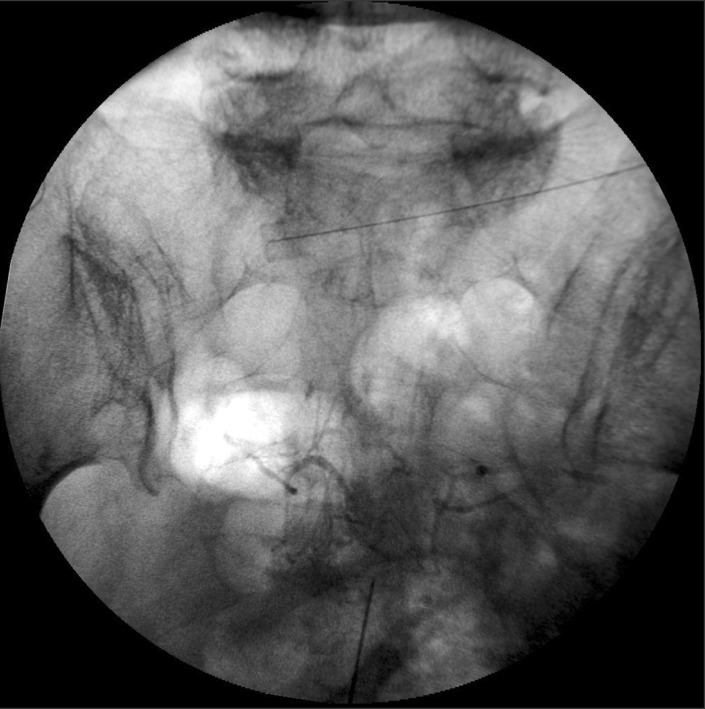Korean J Pain.
2015 Oct;28(4):280-283. 10.3344/kjp.2015.28.4.280.
Anaphylactic Shock Following Nonionic Contrast Medium during Caudal Epidural Injection
- Affiliations
-
- 1Department of Anesthesiology and Pain Medicine, Kangwon National University Hospital, School of Medicine, Kangwon National University, Chuncheon, Korea. arim14@kangwon.ac.kr
- KMID: 2151671
- DOI: http://doi.org/10.3344/kjp.2015.28.4.280
Abstract
- Caudal epidural injection is a common intervention in patients with low back pain and sciatica. Even though the complications of fluoroscopically directed epidural injections are less frequent than in blind epidural injections, complications due to contrast media can occur. We report a case of anaphylactic shock immediately after injection of an intravenous nonionic contrast medium (iohexol) during the caudal epidural injection for low back pain and sciatica in a patient without a previous allergic history to ionic contrast media (ioxitalamate). Five minutes after the dye was injected, the patient began to experience dizziness, and the systolic blood pressure dropped to 60 mmHg. Subsequently, the patient exhibited a mild drowsy mental state. About 30 minutes after the subcutaneous injection of 0.2 mg epinephrine, the systolic blood pressure increased to 90 mmHg. The patient recovered without any sequela. Life-threatening complications after injection of intravenous contrast medium require immediate treatment.
Keyword
MeSH Terms
Figure
Cited by 1 articles
-
The Use of Contrast in Caudal Epidural Injections under Image Intensifier Guidance: Is It Necessary?
Kamil Naidoo, Sulaiman Alazzawi, Alexander Montgomery
Clin Orthop Surg. 2017;9(2):190-192. doi: 10.4055/cios.2017.9.2.190.
Reference
-
1. Cho NH, Jung YO, Lim SH, Chung CK, Kim HA. The prevalence and risk factors of low back pain in rural community residents of Korea. Spine (Phila Pa 1976). 2012; 37:2001–2010. PMID: 22588379.
Article2. Doo AR, Kim JW, Lee JH, Han YJ, Son JS. A comparison of two techniques for ultrasound-guided caudal injection: the influence of the depth of the inserted needle on caudal block. Korean J Pain. 2015; 28:122–128. PMID: 25852834.
Article3. Parr AT, Manchikanti L, Hameed H, Conn A, Manchikanti KN, Benyamin RM, et al. Caudal epidural injections in the management of chronic low back pain: a systematic appraisal of the literature. Pain Physician. 2012; 15:E159–E198. PMID: 22622911.4. Delaney A, Carter A, Fisher M. The prevention of anaphylactoid reactions to iodinated radiological contrast media: a systematic review. BMC Med Imaging. 2006; 6:2. PMID: 16643668.
Article5. Bush WH Jr, Mullarkey MF, Webb DR. Adverse reactions to radiographic contrast material. West J Med. 1980; 132:95–98. PMID: 7385829.6. ten Dam MA, Wetzels JF. Toxicity of contrast media: an update. Neth J Med. 2008; 66:416–422. PMID: 19011267.7. Wolf GL, Arenson RL, Cross AP. A prospective trial of ionic vs nonionic contrast agents in routine clinical practice: comparison of adverse effects. AJR Am J Roentgenol. 1989; 152:939–944. PMID: 2495706.
Article8. Caro JJ, Trindade E, McGregor M. The risks of death and of severe nonfatal reactions with high- vs low-osmolality contrast media: a meta-analysis. AJR Am J Roentgenol. 1991; 156:825–832. PMID: 1825900.
Article9. Brown SG. Clinical features and severity grading of anaphylaxis. J Allergy Clin Immunol. 2004; 114:371–376. PMID: 15316518.
Article10. Katayama H, Yamaguchi K, Kozuka T, Takashima T, Seez P, Matsuura K. Adverse reactions to ionic and nonionic contrast media. A report from the Japanese Committee on the Safety of Contrast Media. Radiology. 1990; 175:621–628. PMID: 2343107.
Article11. Lasser EC, Lyon SG, Berry CC. Reports on contrast media reactions: analysis of data from reports to the U.S. Food and Drug Administration. Radiology. 1997; 203:605–610. PMID: 9169676.
Article12. Trcka J, Schmidt C, Seitz CS, Bröcker EB, Gross GE, Trautmann A. Anaphylaxis to iodinated contrast material: nonallergic hypersensitivity or IgE-mediated allergy? AJR Am J Roentgenol. 2008; 190:666–670. PMID: 18287437.
Article13. Lieberman P, Nicklas RA, Oppenheimer J, Kemp SF, Lang DM, Bernstein DI, et al. The diagnosis and management of anaphylaxis practice parameter: 2010 update. J Allergy Clin Immunol. 2010; 126:477–480.e1-42. PMID: 20692689.
Article14. Wang CC, Chang SH, Chen CC, Huang HL, Hsieh IC. Severe coronary artery spasm with anaphylactoid shock caused by contrast medium--case reports. Angiology. 2006; 57:225–229. PMID: 16518532.
Article15. Manchikanti L, Malla Y, Wargo BW, Cash KA, Pampati V, Fellows B. A prospective evaluation of complications of 10,000 fluoroscopically directed epidural injections. Pain Physician. 2012; 15:131–140. PMID: 22430650.
- Full Text Links
- Actions
-
Cited
- CITED
-
- Close
- Share
- Similar articles
-
- Anaphylactic shock caused by intramuscular injection of midazolam during the perioperative period: a case report
- Spreading pattern of contrast medium in the high thoracic epidural space in rabbits: the effect of neck flexion and extension
- Analysis of thoracic epidurography and correlating factors affecting the extent of contrast medium spread
- Preliminary study on contrast flow analysis of thoracic transforaminal epidural block
- Comparison of Transforaminal Epidural Steroid Injection and Lumbar/Caudal Epidural Steroid Injection for the Treatment of Lumbosacral Radiculopathy


